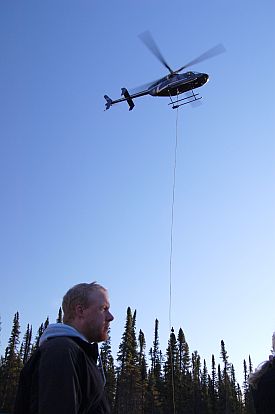 Noront Resources Inc. made history with its 2007 Eagle One discovery in the McFauld's Lake mining camp located in Ontario's James Bay Lowlands.
Noront Resources Inc. made history with its 2007 Eagle One discovery in the McFauld's Lake mining camp located in Ontario's James Bay Lowlands.
It was this high-grade nickel, copper, platinum and palladium discovery that led to a frenzied staking rush never before seen in a region previously described as Northern Ontario's last unexplored frontier.
Over the last three years, Noront found five more deposits on a geological structure known as the Ring of Fire, host to a myriad of mineral deposits that are generating excitement in the exploration and mining community.
"We believe our Ring of Fire assets are extraordinary and offer tremendous opportunity in the future," said Noront's president and CEO Wes Hanson.
The company owns a substantial land package of 48,600 hectares and shares another 68,000 hectares in joint ventures. Since 2007, upwards of $30 million has been invested in exploration and 360 holes were drilled totalling approximately 130,000 metres.
Geologically, the area is "blind," meaning there is no outcrop exposure. Consequently, drill targets are based on airborne geophysical data. Noront has had an estimated 30 to 35 per cent success rate, which has led to its six discoveries all within a 12-kilometre radius. Two of the deposits have an NI 43-101 measured and indicated resource.
Eagle's Nest
The Eagle One deposit, now called the Eagle's Nest, has attracted the most attention. Further drilling to 1,100 metres has shown that the orebody is a continuous band of mineralization of high-grade nickel and copper with platinum and palladium credits. It remains open at depth.
"It is very exciting because it potentially triples the known resource," Hanson said. The Eagle's Nest indicated and inferred resource is almost three million tonnes, grading roughly two per cent nickel and one per cent copper with four to five grams of platinum and palladium credits. Within that exists a high grade component of about 500,000 tonnes indicated and inferred massive sulphides that grade between six and seven per cent nickel and two to three per cent copper with 15 g/t of platinum and palladium.
Two kilometres southwest sits the Eagle Two discovery, Noront's second nickel/copper sulphide deposit. Hanson said the grades are not as rich as those in the Eagle's Nest, but it has some "good thicknesses and decent grades."
Further northeast is the AT12 anomaly, the company's third nickel/copper sulphide deposit. Noront is aggressively continuing work in the hope of further delineating and understanding this mineralized zone.
Two other unique discoveries are the Triple J Zone, a relatively unexplored deposit with high-grade gold showings, and the Thunderbird property comprised of vanadium, titanium and iron.
Blackbird
The Blackbird deposit holds a measured and indicated resource of 8.9 million tonnes grading approximately 35 per cent Cr203. Hanson said they are extensions of the nearby Black Thor and Big Daddy chromite deposits.
"We have a very high grade and good quality chrome-to-iron ratio," he said, adding that this type of resource easily supports an operation with a mine life of 25 to 35 years. However, Noront has never considered the chromite as a stand-alone asset, as its main focus has always been its nickel, copper sulphide discoveries. Therefore, the main focus is on developing the Eagle's Nest and possibly surrounding nickel/copper deposits should they prove economical.
"In the mining business, grade is king," Hanson said. "We have rock value in the Eagle's Nest that is well over $1,500 per tonne in today's metal prices for the massive sulphide components of that deposit."
The company is fully financed for 2010 with plans to invest between $10 and $15 million on exploration in the Ring of Fire district. Presently, the stock is trading between $1.65 and $1.80.
"I'm a professional geologist by trade and have travelled all over the world and been in some of the most prolific mining camps from Russia to Sudbury to South Africa," said Hanson. "I've never seen anything like the Ring of Fire in terms of the diversity of minerals and the quantity and quality of the mineral deposits. In my view, it is unique and I'm very excited to have an opportunity to participate in it."


.jpg;w=120;h=80;mode=crop)